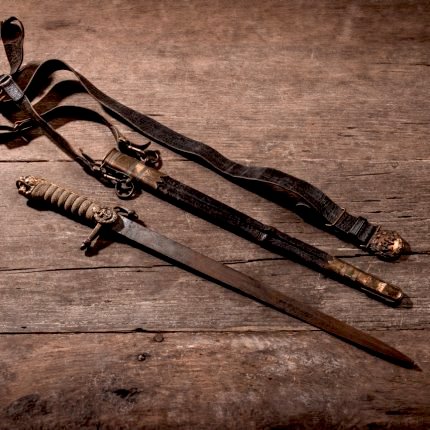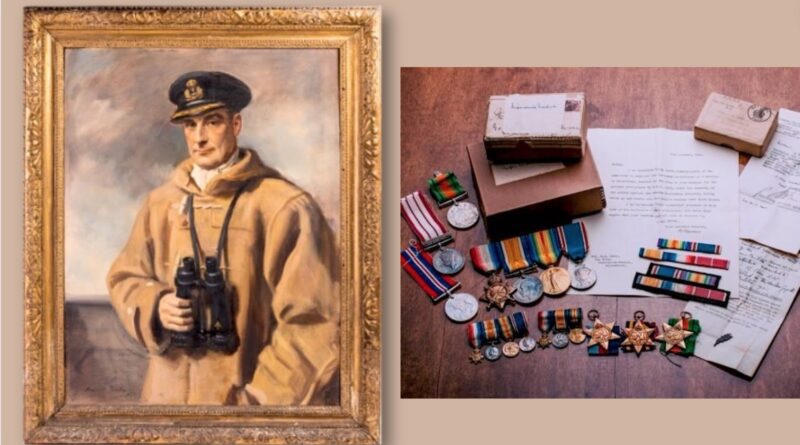HMS Hood captain Ralph Kerr collection commands attention
The private collection of revered naval captain Ralph Kerr CBE (1891-1941), who commanded the ill-fated HMS Hood, saw competitive bidding, according to Dawsons auctioneers in Berkshire.
HMS Hoos was the largest capital ship in Britain, which was sunk by the German battleship Bismarck in the Denmark Strait in May, 1941.
The auction, which saw the collection sell to a private collector in the UK for a hammer of £60,000 against a pre-sale estimate of £5,600 coincided with the commemoration of 83 years almost to the day of the ship’s sinking and the commander’s death, alongside most of his crew, of which there were only three survivors out of 1,418.
Commenting on the sale, auctioneer Peter Mason, said: “It was a privilege for the team at Dawsons to handle the sale of the Captain Kerr collection, on behalf of his family. We are delighted with the result and pleased that our bespoke in-house marketing helped to generate such strong interest from both UK and overseas bidders.”
 Born in Gloucestershire during the Victorian era, Captain Ralph Kerr joined the Royal Navy at the early age of 13. His journey led him through the trials of the First World War, where he distinguished himself at the Battle of Jutland in 1916. Subsequently, he assumed command of HMS Cossack in 1918, marking the beginning of an illustrious naval career. The account of Captain Kerr’s life is one of daring escapades and remarkable resilience. Notably, his leadership aboard destroyers, including several flotillas stationed in the Mediterranean, which earned him widespread admiration. An incident in which he was mistakenly reported drowned, only to prove otherwise, speaks volumes of his character and resolve.
Born in Gloucestershire during the Victorian era, Captain Ralph Kerr joined the Royal Navy at the early age of 13. His journey led him through the trials of the First World War, where he distinguished himself at the Battle of Jutland in 1916. Subsequently, he assumed command of HMS Cossack in 1918, marking the beginning of an illustrious naval career. The account of Captain Kerr’s life is one of daring escapades and remarkable resilience. Notably, his leadership aboard destroyers, including several flotillas stationed in the Mediterranean, which earned him widespread admiration. An incident in which he was mistakenly reported drowned, only to prove otherwise, speaks volumes of his character and resolve.
In early 1941, Captain Kerr’s appointment as Commander of HMS Hood surprised many, given his background in destroyer operations. Tragically, his tenure aboard Britain’s one-time largest and most powerful warship was short-lived. HMS Hood was scheduled to undergo a major rebuild in 1941 to keep up with advances in naval gunnery, but this was not possible due to the outbreak of the Second World War in 1939. Therefore, before any upgrades were possible, the once ‘Mighty Hood’ met its fateful end in the Straits of Denmark at the hands of the fabled German warship Bismarck.
 Kerr’s remarkable medal collection included numerous honours awarded to him throughout his distinguished career, from his early days as a cadet in the Royal Navy, to his command of HMS Hood. They comprised his WWI group, named to Lieut. R. Kerr RN, a George VI Coronation Medal and miniature sets, a Palestine Medal, in its original box of issue, with a letter from the Admiralty dated 30th July 1942. A further letter from the Admiralty featured a bronze oak leaf emblem attached, which was awarded for Kerr’s mention in Despatches (an official report describing a meritorious action that the subject had taken in the face of the enemy).
Kerr’s remarkable medal collection included numerous honours awarded to him throughout his distinguished career, from his early days as a cadet in the Royal Navy, to his command of HMS Hood. They comprised his WWI group, named to Lieut. R. Kerr RN, a George VI Coronation Medal and miniature sets, a Palestine Medal, in its original box of issue, with a letter from the Admiralty dated 30th July 1942. A further letter from the Admiralty featured a bronze oak leaf emblem attached, which was awarded for Kerr’s mention in Despatches (an official report describing a meritorious action that the subject had taken in the face of the enemy).
As well as his WWII medals, were others awarded posthumously, which included a WWII Campaign Medal, a Defence Medal, an Atlantic Star and a 1939-1945 Star, together with a Burma Star, awarded to his son, Captain Russell Kerr, Royal Artillery, 82nd Tank Regt a Royal Artillery commander, killed in Burma in 1945. There was also a Knight Batchelor Badge awarded in 1932 to Russell Kerr and assorted sporting and military competition badges also collected by Russell Kerr.
 Alongside Kerr’s medals was his ceremonial naval sword, a personally issued 1856 pattern midshipman’s dirk and scabbard, made by Wilkinson Sword for Gieves, Matthes & Seagrove. It featured a lion’s head pommel wire bound shagreen grip, acorn tipped quillon and ‘fouled anchor’ boss, with the blade showing decoration of engraved scrolls. It came with a polished black leather scabbard and hangar, with gilt brass furniture, bearing the gothic monogram RK.
Alongside Kerr’s medals was his ceremonial naval sword, a personally issued 1856 pattern midshipman’s dirk and scabbard, made by Wilkinson Sword for Gieves, Matthes & Seagrove. It featured a lion’s head pommel wire bound shagreen grip, acorn tipped quillon and ‘fouled anchor’ boss, with the blade showing decoration of engraved scrolls. It came with a polished black leather scabbard and hangar, with gilt brass furniture, bearing the gothic monogram RK.
Also from Kerr’s estate was a portrait of Captain Kerr by the popular English Royal portrait painter in the early part of the 20th century, Oswald Birley (1880-1952). The artist portrayed Kerr in full uniform, wearing a duffle coat and holding binoculars. The painting, which captured Kerr’s likeness in striking detail, was accompanied by handwritten correspondence from the artist to the sitter’s widow, dating from March 1943 to July 1944, discussing the photographs used, the composition and the clothes in the painting. It also comprised A History of the Family Kerr by Russell J. Kerr, November, 1923, published for Private Circulation by John Bellows, Gloucester in 1923. The oil on canvas was signed Oswald Birley 1943.


